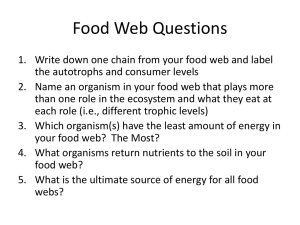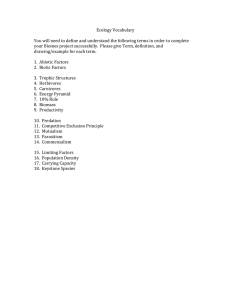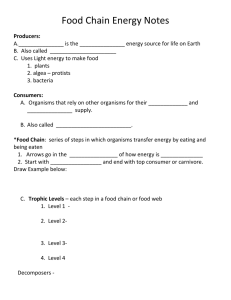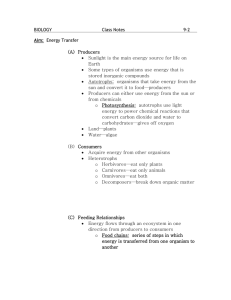Energy Transfer and Food Webs Background
advertisement
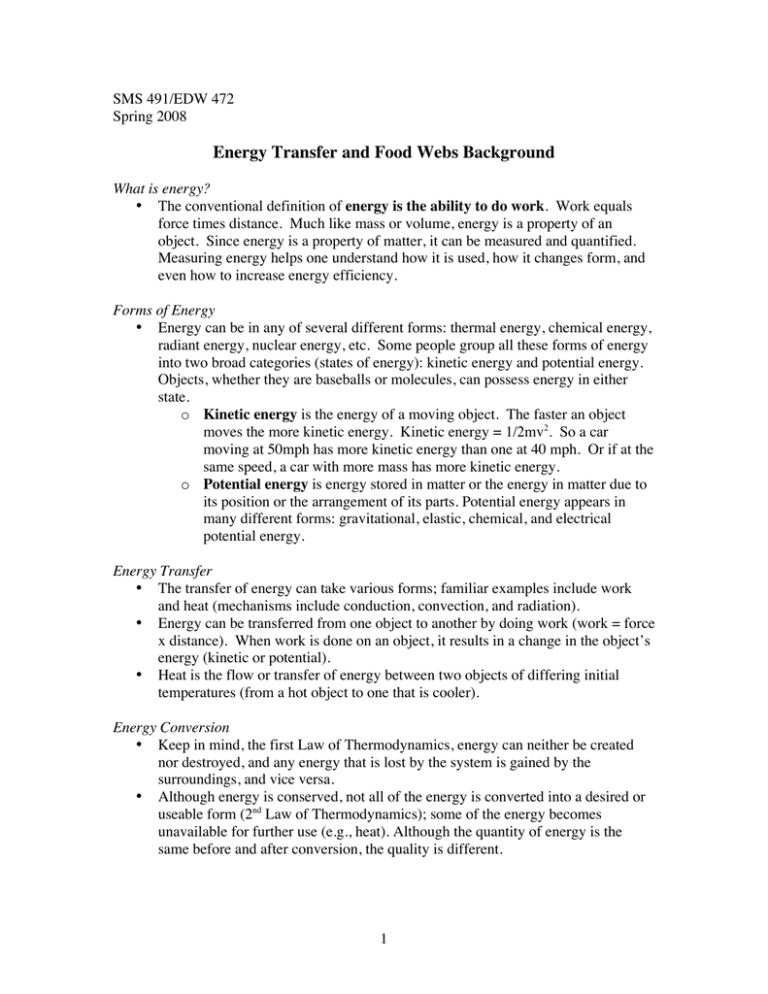
SMS 491/EDW 472 Spring 2008 Energy Transfer and Food Webs Background What is energy? • The conventional definition of energy is the ability to do work. Work equals force times distance. Much like mass or volume, energy is a property of an object. Since energy is a property of matter, it can be measured and quantified. Measuring energy helps one understand how it is used, how it changes form, and even how to increase energy efficiency. Forms of Energy • Energy can be in any of several different forms: thermal energy, chemical energy, radiant energy, nuclear energy, etc. Some people group all these forms of energy into two broad categories (states of energy): kinetic energy and potential energy. Objects, whether they are baseballs or molecules, can possess energy in either state. o Kinetic energy is the energy of a moving object. The faster an object moves the more kinetic energy. Kinetic energy = 1/2mv2. So a car moving at 50mph has more kinetic energy than one at 40 mph. Or if at the same speed, a car with more mass has more kinetic energy. o Potential energy is energy stored in matter or the energy in matter due to its position or the arrangement of its parts. Potential energy appears in many different forms: gravitational, elastic, chemical, and electrical potential energy. Energy Transfer • The transfer of energy can take various forms; familiar examples include work and heat (mechanisms include conduction, convection, and radiation). • Energy can be transferred from one object to another by doing work (work = force x distance). When work is done on an object, it results in a change in the object’s energy (kinetic or potential). • Heat is the flow or transfer of energy between two objects of differing initial temperatures (from a hot object to one that is cooler). Energy Conversion • Keep in mind, the first Law of Thermodynamics, energy can neither be created nor destroyed, and any energy that is lost by the system is gained by the surroundings, and vice versa. • Although energy is conserved, not all of the energy is converted into a desired or useable form (2nd Law of Thermodynamics); some of the energy becomes unavailable for further use (e.g., heat). Although the quantity of energy is the same before and after conversion, the quality is different. 1 Measuring and quantifying energy • Units of energy: the SI unit of energy is the joule (kg-m2/s2), which is the amount of energy required to lift an object that weighs one Newton a one meter distance (along the direction of the force). A more familiar unit of energy is the calorie, which is defined as the amount of energy needed to raise the temperature of 1 gram of water 1°C. One calorie equal 4.184 joules. A related energy unit is the nutritional Calorie (1 Cal = 1000 cal = 1 kcal). • The measurement of energy often uses methods for the measurement of still more fundamental concepts of science (e.g., mass, distance, temperature, etc). • In thermodynamics, the technique most often employed is calorimetry, which relies on the measurement of temperature. Common Energy Misconceptions: (Source: Hapkiewicz, A. (1992). Finding a List of Science Misconceptions. MSTA Newsletter, 38, Winter’92, pp.11-14) • • • • • • • • • Energy is truly lost in many energy transformations. There is no relationship between matter and energy. If energy is conserved, why are we running out of it? Energy can be changed completely from one form to another (no energy losses). Things “use up” energy. Energy is confined to some particular origin, such as what we get from food or what the electric company sells. An object at rest has no energy. The only type of potential energy is gravitational. The terms “energy” and “force” are interchangeable. FOOD WEBS: Movement of energy through ecosystems (food chains and food webs) • Food chain – is a single pathway of energy transfer through an ecosystem as organisms eat one another. The arrows show the direction of energy flow, not the direction of eating. Trophic pyramids describe the linear flow of energy (biomass or productivity) from lower to higher trophic levels. • Food web – a complex set of many interconnected food chains in a system. • Both (graphically) describe the feeding relationships (transfer of energy and material) between organisms in an ecological community. Organisms represented in a food chain • Each “link” in a food chain is a trophic level (feeding level), starting with: o Primary producers (autotrophs) – organisms that are capable of producing complex organic substances from an energy source and inorganic materials. 2 o Consumers (heterotrophs) - organisms that get their energy by consuming organic substances. Herbivores - obtain their energy by consuming live plants. Carnivores - obtain energy from consuming live animals. Detritivores - scavengers and decomposers, which all consume dead biomass. Energy Efficiency • In terms of energy, efficiency means how much of a given amount of energy can be converted from one form to another useful form (i.e., how much of the energy is used to do what is intended compared to how much is “lost” as heat). • Efficiency = useful energy output/ energy input). No energy conversion is 100% efficient. • Most food chains only have a few links in them because energy is lost at each level. • In general, we assume 10% efficiency from one trophic level to the next, meaning that 10% of the energy (material) in transferred, 90% goes back to the environment. Common Food Web Misconceptions: (Source: http://ecomisconceptions.binghamton.edu/foodwebs.htm) • • • • • • • • • • • • • • Varying the population will only affect the organisms that are directly connected through a food chain. Plants take in food from the outside environment, and/or plants get their food from the soil via roots. Food webs are interpreted as simple food chains. Organisms higher in a food web eat everything that is lower in the food web. The top of the food chain has the most energy because it accumulates up the chain. Populations higher on a food web increase in number, because they deplete those lower in the food web. The relative sizes of prey and predator populations have no bearing on the size of other. In a food web, a change in one population will only affect another population if the two populations are directly related as prey and predator. There are more herbivores because people keep and breed them. Plants are dependent on humans, not vice versa. An organism cannot change trophic levels. Food chains involve predator and prey, no producers. Carnivores are big and ferocious. Herbivores are passive or smaller. Carnivores have more energy or power than herbivores. 3
